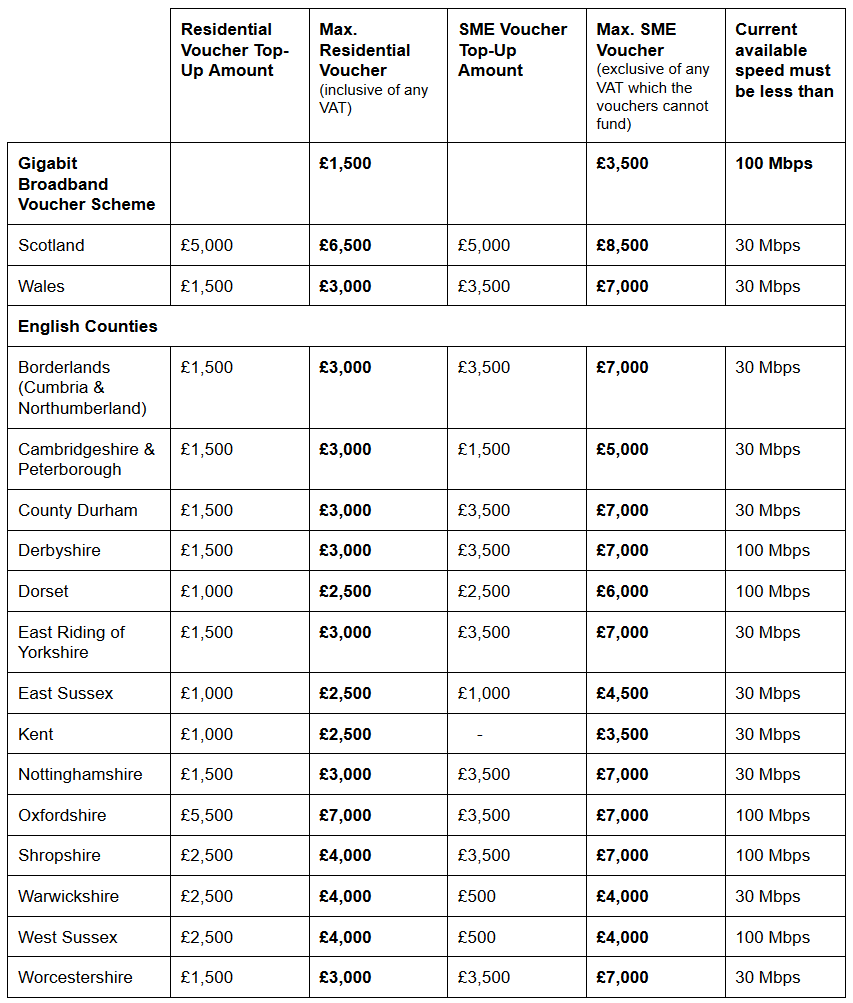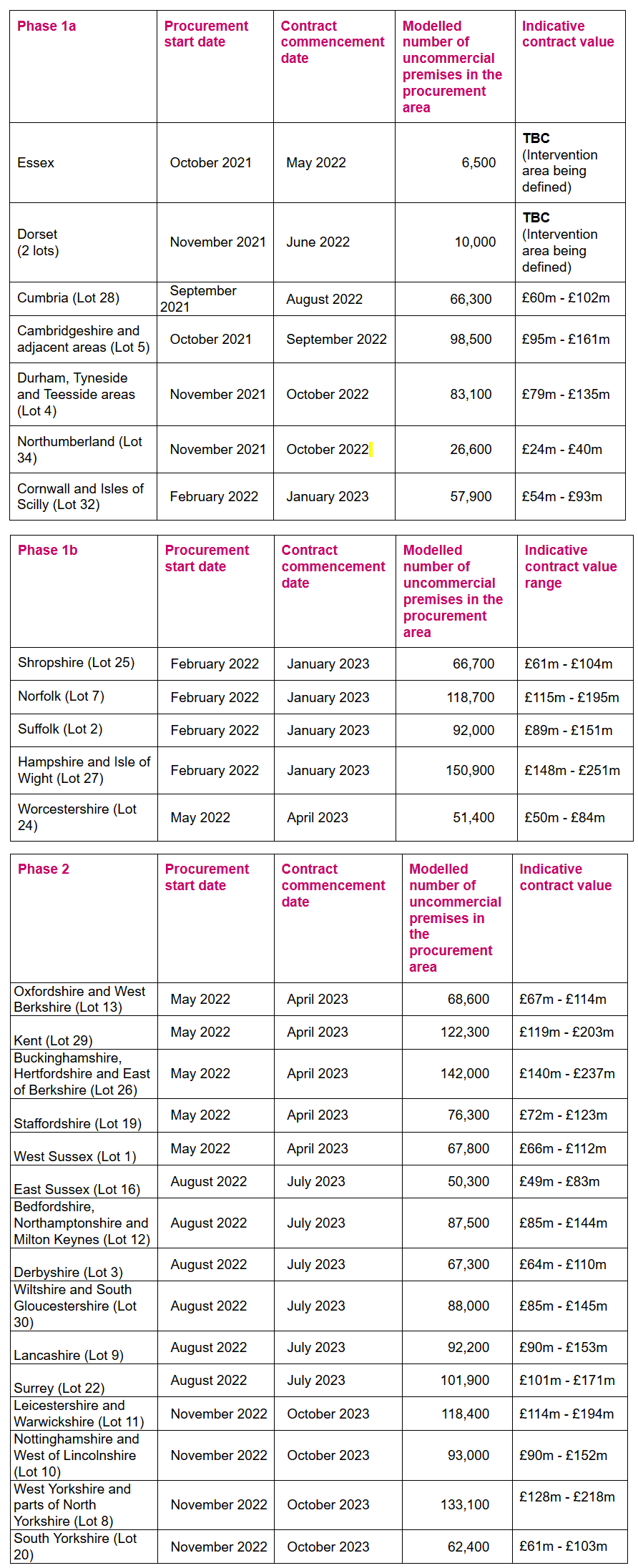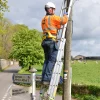Gov Publish Next Phase of UK Rural Gigabit Broadband Rollout Plan

The UK Government will today publish the next phase (inc. Phase 1a, 1b and 2) of their £5bn Project Gigabit programme, which in this batch aims to spread 1Gbps capable broadband ISP networks to a further 1.85 million rural premises (2.2 million confirmed so far) across 26 counties in England. Gigabit vouchers have also been boosted.
Just to recap. Project Gigabit seeks to extend such speeds to reach at least 85% of UK premises by the end of 2025, and they also aim to get “as close to 100% as possible” – depending upon how the industry responds (i.e. so far only £1.2bn has been released from the budget, but more will be unlocked if the industry shows they can deliver what is needed).
At present around 42% of UK premises can already access a gigabit-capable network (c.24% via just FTTP), which should reach about 60% by the end of 2021, and it’s hoped that commercial deployments could then push this up to around 80% by the end of 2025 (mostly in urban areas). As a result Project Gigabit is exclusively focused upon improving connectivity to those rural and semi-rural areas in the final 20% (5-6 million premises).
Advertisement
The project actually consists of several support schemes, including gigabit vouchers (£210m), funding to extend Dark Fibre in the public sector (£110m) and gap-funded deployments with suppliers (rest of the funding). In today’s article we’re focused on the latter, which sees ISPs bidding – via a new Dynamic Purchasing System (DPS) run by the Building Digital UK (BDUK) team – to extend their networks across rural parts of the UK.
The Latest Procurement Areas
The first procurement phase (Phase 1a) of this project was announced in March 2021 and that covered parts of Cambridgeshire, Cornwall, Cumbria, Dorset, Durham, Essex, Northumberland, South Tyneside and Tees Valley. The next set of procurements cover many more areas in England (see bottom of article), stretching across 26 counties.
Almost half a million (480,000) premises in Shropshire, Norfolk, Suffolk, Worcestershire, Hampshire and the Isle of Wight will be among the first to benefit, followed by counties including Derbyshire, Wiltshire, Gloucestershire, Lancashire, Surrey, Leicestershire, Warwickshire, Nottinghamshire, Hertfordshire, Staffordshire, Lincolnshire and Yorkshire.
Oliver Dowden MP, UK Digital Secretary, said:
“Project Gigabit is our national mission to level up rural areas by giving them the fastest internet speeds on the market.
Millions more rural homes and businesses will now be lifted out of the digital slow lane thanks to our mammoth £5 billion investment and one the quickest rollouts in Europe.
This broadband revolution will create jobs, power up businesses and allow everyone to access vital services at lightning fast speed, helping us build back better from the pandemic.”
Naturally, we won’t know the final plan for each of the larger procurement areas, as listed below, until suppliers have been chosen for each of them and a rollout plan is completed. The government have today indicated that the first contracts are expected to commence in May 2022, and we’d normally then expect to see a rollout plan emerge a few months after such an award (i.e. building won’t start until the latter half of 2022). The first rollout phase will include 349,000 premises in Essex, Dorset, Cumbria, Cambridgeshire, Northumberland, Durham, Tyneside, Teesside and Cornwall.
Advertisement
Bidders on the aforementioned LOTS will be required to ensure that their networks are available for use by other ISPs via wholesale (open access). Various operators, both big and small (e.g. Openreach, Cityfibre, Gigaclear, Cityfibre, Virgin Media [VMO2] etc.), are expected to take part and areas with sub-30Mbps speeds will be prioritised, albeit NOT to the exclusion of all else.
On top of this, today it is also being confirmed that the Scottish and Welsh governments and 15 English councils have made at least an extra £26 million available in top-ups to the UK Government’s Gigabit Broadband Voucher Scheme. The scheme, which is available nationwide, covers the costs of a gigabit connection in areas that are particularly difficult to reach, and the top-ups boost the financial help available (i.e. bigger vouchers make it possible to reach some increasingly remote rural areas). Sadly, many councils still appear to be missing from this list, which is likely to disrupt some deployment projects and plans.
BDUK Summary of New Voucher Top-up Values

Advertisement
Finally, we should add that the Government has previously warned that those in the final 1% may still be “prohibitively expensive to reach“, although they’ve recently clarified that less than 0.3% of the country (i.e. under 100,000 premises) are likely to fall into this category (roughly the same gap that the 10Mbps USO has struggled to fill). Solutions for those in the final 0.3% of “Very Hard to Reach” premises are currently being explored.
The government concluded by saying that more procurements are due to be announced “over the coming months” across England, Scotland, Wales and Northern Ireland. Meanwhile, details on the key dates, number of premises and estimated contract value ranges for phases 1a (areas announced in March), 1b and 2 are published in the tables below.
As usual, these won’t be automatic upgrades for consumers, so once the new network is built then you’ll still need to order it from a supporting ISP.

Additional info on the table:
Contract commencement date: The expected start date of the new commercial activity.
Number of premises: The number of premises in scope of the procurement and expected to be uncommercial and require public funding – either as modelled by DCMS or as superseded following Public Review and Pre-Procurement Market Engagement. This value may change significantly leading up to commencement of the procurement process
Indicative contract value: Low – An indicative lower bound on the expected contract value – determined by applying a relatively low average subsidy per premises passed to the number of premises expected to be in scope and affordable. High – An indicative upper bound on the expected contract value – determined by applying a relatively high average subsidy per premises passed to the number of premises expected to be in scope and affordable.
Alongside all this, the government are conducting various public reviews and OMRs, which is the process that they and local bodies often use when trying to identify existing commercial coverage of gigabit-capable broadband networks and any planned coverage over the next c.3 years. By doing that, they can more easily target their support towards areas where commercial projects are not expected to reach (i.e. the intervention area).
UPDATE 9am:
A few more details from BDUK this morning. On the next (future) set of Regional Supplier procurements (Phase 3) following Phases 1 and 2, the following locations are currently being listed (we don’t know in what order these will actually be announced yet):
● Birmingham and the Black Country (Lot 35)
● Cheshire (Lot 17)
● Devon & Somerset (Lot 6)
● Herefordshire & Gloucestershire (Lots 15, 18)
● Dorset (Lot 14) (note some Local Supplier contracts are being progressed here)
● Essex (Lot 21) (note some Local Supplier contracts are being progressed here)
● Lincolnshire (including NE Lincolnshire and N Lincolnshire) and East Riding (Lot 23)
● Greater London (Lot 37)
● Merseyside and Greater Manchester (Lot 36)
● Newcastle and North Tyneside (Lot 38)
● Northern North Yorkshire (Lot 31)
● Remaining projects in Scotland, Wales and Northern Ireland not incorporated in earlier phases (Lots TBC)
So-called “Regional Supplier” procurements are important (most likely involving major operators), but are just one tool in the delivery toolkit. In areas where the Regional Supplier procurement is scheduled later, BDUK say they are working with local authorities to accelerate “Local Supplier” procurements (typically each Lot covering 1,000–8,000 premises) and to encourage and facilitate voucher-funded projects, where these deliver greater benefit in the short term. Essex and Dorset (Phases 1 and 2) are both Local Supplier procurements, while the rest are regional (so far).

Separately, we note that there have been a couple of changes since March 2021, which mostly reflects the impact from Openreach’s expanded commercial FTTP rollout (i.e. BDUK have tweaked several Lots to make them more attractive). The two previously announced Cornwall lots (Lots 32 and 33) have been merged. On top of that, the lots around Cumbria (Lot 28), Northumberland (34), Durham, South Tyneside and Tees Valley (4) will also be reconfigured to more closely align to county boundaries.
Finally, the Government are also making available up to £90 million of additional funding to extend contracts awarded under the previous Superfast Broadband (SFBB) programme, which are already delivering gigabit access to some of the hardest to reach premises that cannot currently get “superfast” speeds (30Mbps). “We are particularly targeting contracts in the devolved nations (set out below) and specific pockets within England, where we are seeking suitable, value for money proposals from existing suppliers,” said BDUK.
● Following the £4.5 million boost for Scotland’s R100 Central contract to extend gigabit coverage to an additional 5,000 premises (here), we are exploring the opportunity to deliver further gigabit coverage through the R100 Northern contract.
● We are exploring further opportunities for gigabit-capable solutions through Northern Ireland’s Project Stratum (here) and through Superfast Wales (here).
● There remains a small number of contracts within England with the potential for extension, however these are more likely to be superseded by Project Gigabit Regional or Local Supplier procurements.
Mark is a professional technology writer, IT consultant and computer engineer from Dorset (England), he also founded ISPreview in 1999 and enjoys analysing the latest telecoms and broadband developments. Find me on X (Twitter), Mastodon, Facebook, BlueSky, Threads.net and Linkedin.
« Ecom’s Remote Rural FTTP Broadband Reaches Hillesden in Bucks























































Still don’t understand what happens at copper switch off.
Do these 1% (0.3%) loose their phone connections?
I think it’s highly likely these premises are also going to be in ‘no coverage’ mobile areas too, people that rely on a land line.
If they do have a land line there must be a route (including wayleaves) which the fibre could follow. If land owners are arguing that a piece of plastic covered copper across their land is that different to a piece of plastic covered glass/plastic, we should chop their BB off and see how they like it!
Copper switch-off will be phased over many years, so it’ll probably be running long past 2030 I would have thought. But before that happens you’d need to be covered by FTTP (technically G.fast too, but that’s no longer being built at scale).
The PSTN closes in 2025 – anyone still using a POTS line at that point will have their service changed to be VoIP – you only need 100kbps max for a voice connection. I doubt there’s a phone line in the country that can support baseband telephony that can’t also manage a 100kbps connection.
The PSTN switch-off is of course the first step, but not the same thing as the total switch-off of copper lines themselves, which comes later. It can be a bit confusing to communicate these two sides of the same coin.
Again Rural Lincolnshire forgotten about!, I suppose I can still be happy with my 1.5mbps speeds
, might as well get rid of my dishwasher as wash the pots by hand whilst waiting for emails to download !,
As the article says, more will be announced over the coming months. BDUK has a huge and complex task here, so it’s being done in phases and seems to be moving fairly rapidly, at least in comparison to prior programmes. The West of Lincolnshire does get a mention above too.
Yes.South Holland gets nothing again (south of the county). Despite BT leaving a fibre DP at my pole a few years back, they abandoned the spine build in BDUK and left the equipment to taunt me! 1.5mbps is all we’ll get which will be fine for VoIP but that’s not really cutting the mustard in the 21st century… Who’s representing the last 100k prems?
Still nothing for Cheshire – not in the current BDUK planned procurement phasing and no local authority top up scheme.
Phase 3 – although the moribund state of Connecting Cheshire doesn’t exactly inspire confidence.
The slow fibre rollout started at the very beginning by giving out the initial contracts to the cities. If it had been a pre condition to lay fibre to rural areas with government subsidies before large city contracts were awarded, we would all have been on high speed fibre 10 or 15 years ago.
That seems unlikely. The rollout of ADSL only really took off in 2003.
The government hasn’t awarded large city contracts in the main. They’ve been commercial rollouts by operators spending their own (or their investors’) money.
@Mark – do you have a source URL for this information please?
Ah. Found it thanks
https://www.gov.uk/government/news/two-million-rural-homes-and-businesses-to-benefit-in-5-billion-broadband-upgrade
This is better:
https://assets.publishing.service.gov.uk/government/uploads/system/uploads/attachment_data/file/1007788/Project_Gigabit__Summer_Update_Accessible_PDF_2_Aug_2021__1_.pdf
Mark, that document refers to 3m rural premises for BT (may be 3m of the extra 5m), while BT announced plans are 6.2m area 3 premises.
This document should be showing a big reduction in the intervention area. 6.2m area 3’s does not leave an enormous amount.
What’s happened to Devon? We live in an are only 6 miles from Exeter, and 2 miles from 2 fibre boxes but no one is talking of bringing good bb to our area for years. There are three villages, lots of farms and small businesses in the area but Openreach et al just don’t seem interested. Download speeds hover around 2mbps on a good day, way below the 10mbps we were all promised as a minimum a long time ago.
Struggling to see where in Tyneside counts as rural. Northumberland yes, Durham yes but there is nothing rural in Tyneside.
It would be very interesting to get an FOI request in to see exactly where the “uncommercial properties” are within each area; to see what their criteria is and what model parameters they have used.
Good luck with that! From our experience, past FOI requests for more details on dodgy BDUK contracts usually resulted in not being processed, often with lame excuses.
Could also just note they refer to studies and OMRs. They don’t calculate anything, they look at what’s covered already and ask operators to inform of their plans over the intervention period.
That’s literally it. There aren’t people crunching numbers and deciding what is and isn’t commercial, that is done by the private sector as they’re the ones who know how much they are willing to spend and where they intend to build.
Ah I see, models, excuse me.
This is just a premises count, it’s not the exact areas that will be subsidised so no point in wasting your time on it.
As noted in the article study of currently served premises alongside an OMR to request coverage plans from operators will be done.
Operators will be inclined to provide their plans as they’ll have no desire to compete with publicly subsidised FTTP.
North Lincolnshire shafted again. Before because we voted Labour, now that the Tories got in, just taken for granted… BT Openreach “fibre” gets you 10 mbps download speed if you are lucky… 0.5 mbps upload. And if you try changing to a 4G provider… tough! No signal guaranteed indoors.
Probably bears repeating to ensure contact your local council and MP about poor broadband in your area.
People can’t fix things that they don’t know exist. Just speaking in general.
Again compare and contrast North Sea Gas rollout with this fiasco.
HMG should be financing extension to outliers, both rural and city based like train travel had gone out of fashion. . . Where’s the dosh saved on the deferrment/cancellation of the Leeds extension to HS2 going ?
I’ve got relatives in Devon with young families, both partners out-to-work and even though the estate is new they can only get an ADSL service and mobile coverage is patchy/poor.
In my part of suburban Harrow G.Fast is only available on request at cost of thousands borne by the customer, and 5G is realistically only available to the pupils and staff attending Harrow school on the hill.
Is HMG Treasury deliberately holding back on spend in the hope that competition fom the “Space-based” web will compel the terrestial providers to “Get-on-with-it” and no extra cost go HMG ?
Can the economy afford to wait ?
‘ Where’s the dosh saved on the deferrment/cancellation of the Leeds extension to HS2 going ?’
The cost overrun of the London to Birmingham leg.
FTTP is rolling out – Kenton Road exchange seems to have completed. I’m in Colindale which BT aren’t upgrading but Community Fibre has deployed here.
VM is also quoting 1 gig for Brent – is it not doing this for Harrow?
Great article as always Mark!
I live in a non-rural area of Lancashire and average speed on my street is just over 15mb with FTTC. We were exploring the option of self-funding an FTTP deployment through Openreach, however it would obviously be preferable to not pay ourselves as the cost would be £1100+ per property (assuming everyone joins in).
The fact we’re on the plan is re-assuring, however it says there are only 92k residences modeled for Lancashire (significantly lower than the 600k ish residential properties across Lancashire). At what point could we feasibly expect to know whether our specific street would be included within the plans?
£5bn isn’t enough to spread 1Gbps capable broadband to a further 1.85 million non-rural premises across 26 counties in England, let alone rural ones.
Guess vanity projects like HS2 provide far more openings to line the pockets of friends than broadband infrastructure does.
It remains to be seen, but the hope is that there will be some match-funding from the private sector.
Anyone know when Lot 37 will be installed? I am in East London and my area for some reason is only allowed to get 60MB Sky and BT whereas just outside my area they get Virgin Media. I am in Tower Hamlets Borough on the borderline of Hackney, whereas Hackney borough seem to already have Virgin Media.
What the hell is going on with wales, I’m in the southwest, near Carmarthen and we are still on 80Mbps… some places don’t even get fiber…